Clean Up Week
About this time of year almost 100 years ago, Johnson & Johnson would have been reminding you that it was time for Clean Up Week. What was Clean Up Week, and why was a company nagging people to clean their houses and yards?
Clean Up Week was a concept promoted by Johnson & Johnson to rally people around spring cleaning...which leads us back to the question: Why did the people at Johnson & Johnson feel they needed to remind people to clean their houses? It's not as if they were planning a visit.
The reminders were due to something else entirely: the Company’s commitment to public health and reducing the spread of infectious diseases. So the idea behind Clean Up Week wasn’t just to spruce up your house after a long winter or get rid of clutter, it was to really scrub any areas in which germs could be lurking. That was critically important in the days before antibiotics and vaccines, when the warmer weather of spring all too often brought the resurgence of diseases such as polio, diphtheria, measles, smallpox, typhoid, whooping cough, and more. The Clean Up Week campaigns were designed to educate the public so that they could help reduce the spread of these illnesses and keep their families and communities safer.
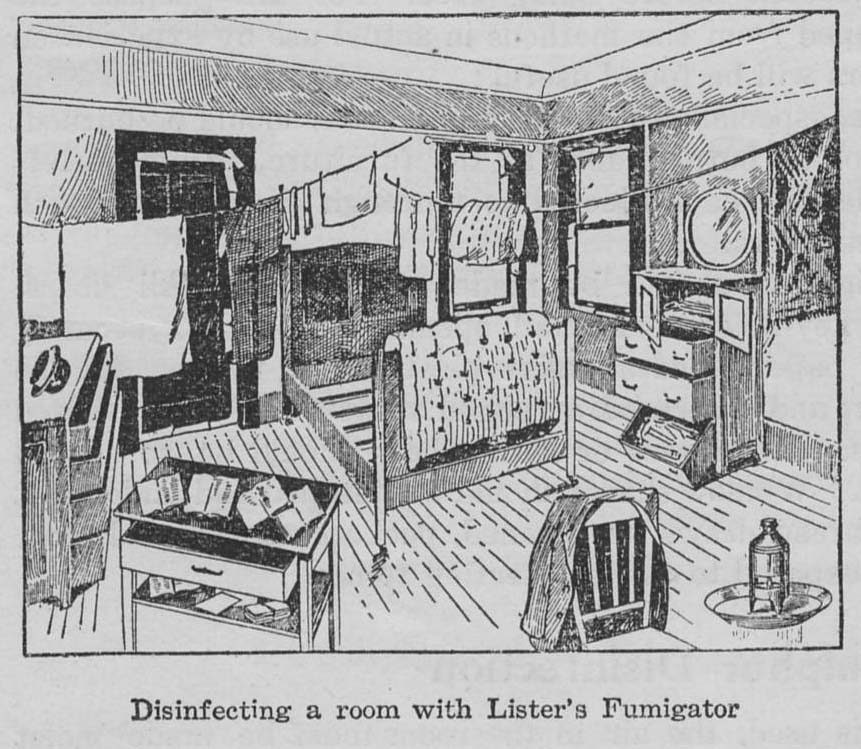
Illustration of Lister's Fumigator, one of the Company's early products, at work.
Here’s what the March, 1917 edition of THE RED CROSS MESSENGER (our publication for retail pharmacists) said:
“Clean-up time means much more than it did a few years ago to most people. Now they do not simply plan to clean-up for the sake of tidiness. They clean to protect their homes, to make them safe for their children…to disinfect and fumigate their homes and to freshen living rooms and bed rooms and kill disease germs.” [THE RED CROSS MESSENGER, Vol. IX, No. 5, March 1917, p. 132]
So Johnson & Johnson ran full-page color ads in national magazines such as Good Housekeeping, Designer, Woman's Magazine, Cosmopolitan and Pictorial Review announcing Clean Up Week. The ads were beautiful and eye-catching, and featured a woman in full “cleaning the house” attire of that era, as well as hands holding a variety of Johnson & Johnson products that could be used for Clean Up Week. These products included the antibacterial soaps Synol Soap and Camphenol, as well as fumigators (to get rid of disease-causing insects) and gauze (to use as scrubbing cloths).
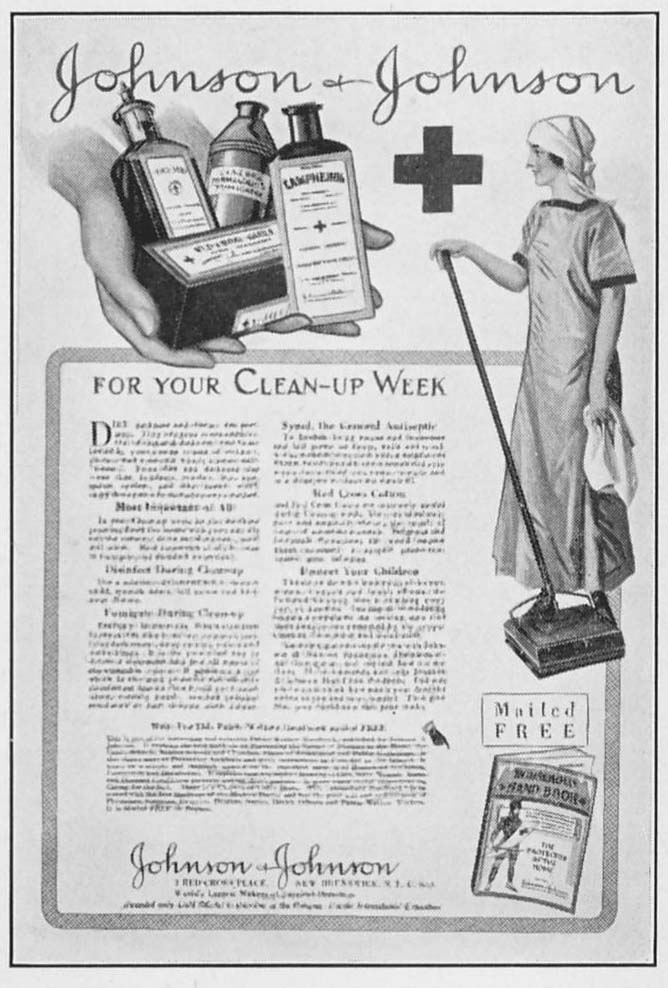
Black and White reproduction of a 1917 Clean Up Week ad
The ads also promoted the giveaway of a Household Hand Book free to anyone interested. The Household Hand Books were distributed by retail druggists, and could be imprinted with the name and address of the drugstore. THE RED CROSS MESSENGER ran articles urging druggists to become leaders in their community with regard to public health, by distributing the handbooks and encouraging people to come to them for advice and supplies that they could use to clean up their homes and protect their families.
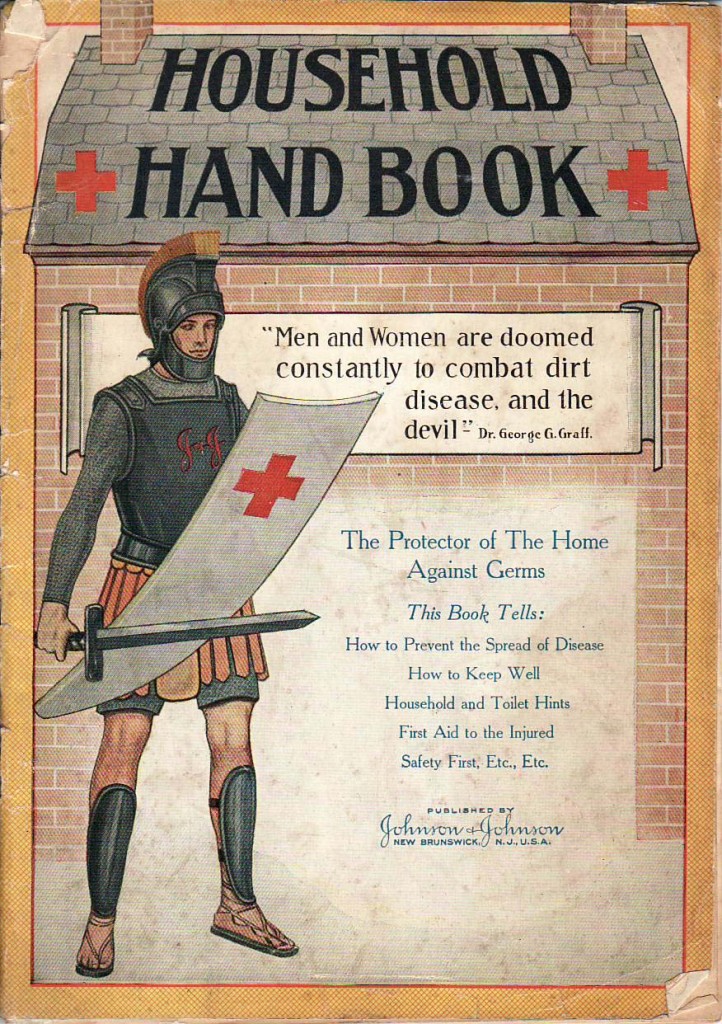
The Household Hand Book had a beautiful full-color cover, featuring a knight dressed in an odd combination of medieval and ancient Roman armor, with a “J&J” on his chest, ready to protect the home against germs, and standing in front of a banner with the dire-sounding quote “Men and Women are doomed constantly to combat dirt disease, and the devil.” Naturally, Fred Kilmer was the editor of the Hand Book, and he thought of everything a family could potentially need from the publication. The first page had space to write the contact information for the nearest doctor, druggist, hospital, police and fire station. The introduction stated:
“The mission of this book is to assist in the war against disease and to aid in the conservation and promotion of health and life. It is a book for every-day use by the individual, in the household, camp, shop, factory or community. Primarily the book points out the way to prevent the spread of sickness and disease. The teachings of the book are based upon the highest and most modern authorities in hygiene and sanitation.” [Household Hand Book, 1917, inside front cover.]
The Household Hand Book contained advice on how to avoid contagious disease, pointers on caring for a sick patient and proper conduct in the sickroom, how to recognize the symptoms of different illnesses, how diseases are spread, how to disinfect your home, when to send for the doctor, first aid information, and more mundane things like how to care for your baby, proper daily care of the teeth, and commonsense advice on how to avoid accidents. If you were part of a household in 1917, you would not only want a copy of the Household Hand Book, you would probably refer to it constantly. After the national Clean Up Week ads ran, the Company was inundated by requests for the Household Hand Book from across the U.S.
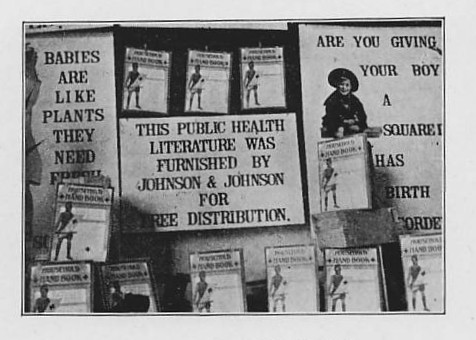
Public Health Display of Household Handbooks, 1918
People would have rushed to their local drugstore to get the materials they would need, as recommended in the Clean Up Week ads. And because Johnson & Johnson educated retail pharmacists about its products, the pharmacists could speak knowledgeably (if they had read the materials) about how the Company’s products such as antibacterial soaps and fumigators worked, how they were manufactured, and how they could help people keep their families safe.
In 1918, during World War I, the Clean Up Week campaign was portrayed as a home-front war measure in defense of the home from germs. Once again, the Company enlisted the help of the retail pharmacists who sold our products to inaugurate Clean Up Weeks in their towns, urging them to get the cooperation of the mayor, the town’s merchants and the schools.
By the way, here’s a list of places in and outside the house that people were urged to clean and disinfect during Clean Up Week. Inside the house: ceilings, floor, doors, closets, garrets, windows, baseboards, cupboards, stairways, cellars, window frames, sashes and glass. Outside the house, people were advised to clear brush and rubbish in back yards, clean vaults and sewers, stagnant pools, gutters, barnyards, chicken houses, drains, stables and dog houses.
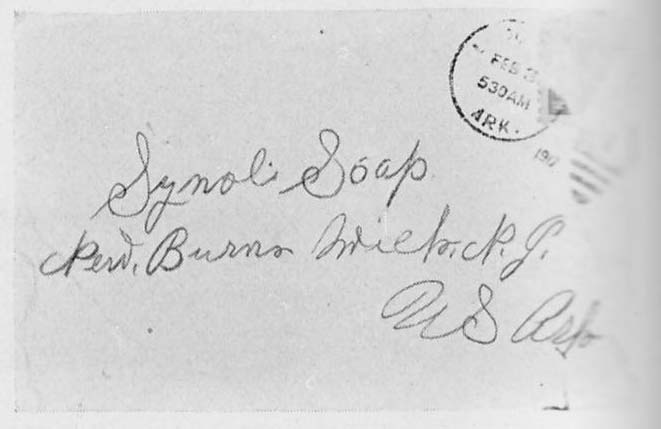
Postcard from the Nineteen Teens, addressed to "Synol Soap" (instead of Johnson & Johnson) in New Brunswick, N.J.
Once readers recovered from the backbreaking and exhausting task of spring cleaning in the Nineteen-Teens, they could be sure that they were, as the cover of the Household Hand Book said, “The Protector of The Home Against Germs,” an important mission and a necessity over 90 years ago.

I continue to enjoy all the Kilmer articles and stories. I love reading the historical information, which also includes the current events of the day. EXTREMELY FASCINATING AND INTERESTING!!
thanks, Marcia
I have only recently discovered Kilmer House and thoroughly enjoy the articles, this one especially helps me to understand why my mother-in-law (aged 87) insists on a total house clean for the start of the new year as her mother had before her - sanitation not being then what it is now and ingrained habits being hard to break.
I look forward to your next article.
Kind regards
Jan
I agree with Marcia the Kilmer House articles are fascinating and in addition they have a great touch, showing the Company's attempt to address the public health concerns of 100 years ago by distributing free pamphlets to educate citizens about disease and its spread. And the Clean Week campaign had the twin benefit of helping our company grow. Come to think of it, 100 years later, not much has changed. We are in the middle of a swine flu epidemic so maybe resurrecting Clean Week and avoid germs would not be such a bad idea! Keep the articles (and the good ideas) coming.
James
Keep up the great work on J&J history Margaret! It's worth noting that this clean-up campaign all happened just before the terrible flu pandemic which began in March of 1918.
Interesting story, I would love to see a copy of the Household Handbook. I have only just discovered your Kilmer website but I will be back again! The JNJ history is fascinating to me. Thank you.
Beverly
What a wonderful article!!!!!! It's like a lesson from history and it's quite interesting to read. I give you A+
Do you have more articles on house cleaning? http://lnk.sk/avwd
I found this article extremely fascinating! I recently heard Rev. James Meeks of Chicago IL., mention Clean Up Week in one of his sermons. I'm so glad I found this article. I found it an informative find, it's principles still hold value, and it was very inspiring. Keep it up! And I'll keep catching up!